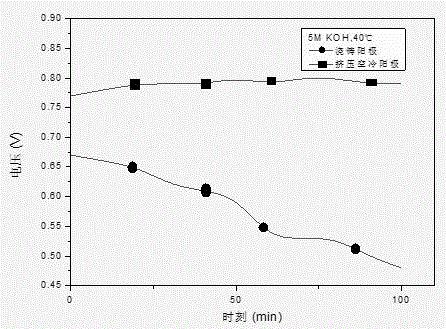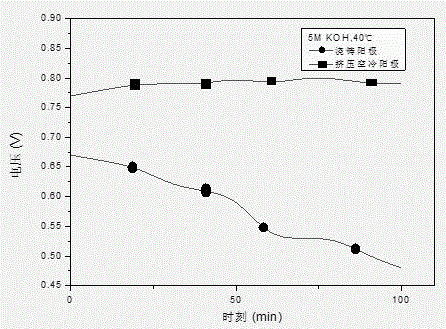Hot-pressing air-cooling forming process for anode aluminum plate for aluminum air cell
A technology of aluminum-air battery and forming process, which is applied in the field of hot-pressing and air-cooling forming process of anode aluminum plate for aluminum-air battery, can solve the problem of reducing discharge current density, voltage and power density, increasing internal resistance of battery, and inability of battery to output stably for a long time. and other problems, to achieve the effect of improving power density and stability and eliminating the passivation layer
- Summary
- Abstract
- Description
- Claims
- Application Information
AI Technical Summary
Problems solved by technology
Method used
Image
Examples
Embodiment 1
[0024] A hot-pressing and air-cooling forming process of an anode aluminum plate for an aluminum-air battery, comprising the following steps:
[0025] a) Melting: Under the protection of inert gas, the alloy aluminum ingot is smelted at a temperature of 735°C to obtain a liquid alloy liquid; the alloy aluminum ingot is an aluminum-magnesium binary alloy, and the percentage of magnesium is 0.5%;
[0026] b) Rod casting: casting the alloy liquid obtained in step a) into an aluminum rod, and rapidly cooling after holding at 570°C for 6 hours;
[0027] c) Extrusion: heat the aluminum rod obtained in step b) to 455°C, and extrude it into an aluminum profile 5 times;
[0028] d) Post-processing: Extrude the aluminum profile obtained in step c) from the extruder and then air-cool it at a rate of 115°C / min to obtain an anode aluminum plate for an aluminum-air battery. The hardness of the aluminum profile is 8 Webster hardness, and the aluminum The thickness of the profile is 2mm.
Embodiment 2
[0030] A hot-pressing and air-cooling forming process of an anode aluminum plate for an aluminum-air battery, comprising the following steps:
[0031] a) Melting: Under the protection of inert gas, the alloy aluminum ingot is smelted at a temperature of 740°C to obtain a liquid alloy liquid; the alloy aluminum ingot is an aluminum-magnesium binary alloy, and the percentage of magnesium is 1%;
[0032] b) Rod casting: casting the alloy liquid obtained in step a) into an aluminum rod, and rapidly cooling after holding at 520°C for 5 hours;
[0033] c) Extrusion: heat the aluminum rod obtained in step b) to 400°C, and extrude it into an aluminum profile for 3 times;
[0034] d) Post-processing: Extrude the aluminum profile obtained in step c) from the extruder and then air-cool it at a rate of 120°C / min to obtain an anode aluminum plate for aluminum-air batteries. The hardness of the aluminum profile is 10 Webster hardness, and the aluminum The thickness of the profile is 0.5mm....
Embodiment 3
[0036] A hot-pressing and air-cooling forming process of an anode aluminum plate for an aluminum-air battery, comprising the following steps:
[0037] a) Melting: Under the protection of inert gas, the alloy aluminum ingot is smelted at a temperature of 750°C to obtain a liquid alloy liquid; the alloy aluminum ingot is an aluminum-magnesium binary alloy, and the percentage of magnesium is 1.5%;
[0038] b) Rod casting: casting the alloy liquid obtained in step a) into an aluminum rod, and rapidly cooling after holding at 610°C for 8 hours;
[0039] c) Extrusion: heat the aluminum rod obtained in step b) to 470°C, and extrude it into an aluminum profile 8 times;
[0040] d) Post-processing: Extrude the aluminum profile obtained in step c) from the extruder and then air-cool it at a rate of 125°C / min to obtain an anode aluminum plate for aluminum-air batteries. The hardness of the aluminum profile is 12 Webster hardness, aluminum The thickness of the profile is 0.5mm.
PUM
| Property | Measurement | Unit |
|---|---|---|
| thickness | aaaaa | aaaaa |
| thickness | aaaaa | aaaaa |
| thickness | aaaaa | aaaaa |
Abstract
Description
Claims
Application Information
 Login to View More
Login to View More - R&D
- Intellectual Property
- Life Sciences
- Materials
- Tech Scout
- Unparalleled Data Quality
- Higher Quality Content
- 60% Fewer Hallucinations
Browse by: Latest US Patents, China's latest patents, Technical Efficacy Thesaurus, Application Domain, Technology Topic, Popular Technical Reports.
© 2025 PatSnap. All rights reserved.Legal|Privacy policy|Modern Slavery Act Transparency Statement|Sitemap|About US| Contact US: help@patsnap.com



